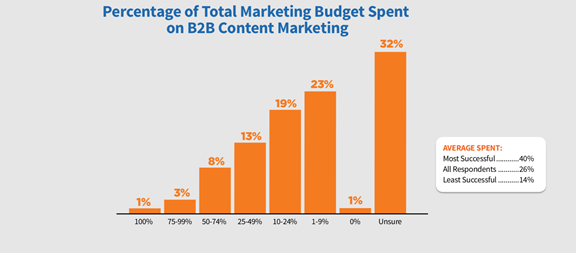In many ways, marketing is the lifeblood of your business. While sales bring in the revenue and drive the company, without a strong marketing approach customers will not discover you.
Crossing fingers and hoping for word of mouth or dumb luck is not a viable or healthy method for a strong, vibrant business. You may know of one or two local companies that have succeeded using such methods, you likely know dozens more that failed because of the lack of quality marketing, despite having a quality product.
One of the best ways to grow your business is by taking advantage of content marketing. Content marketing offers limitless potential, no matter the industry or your target audience. By properly taking advantage of what content marketing has to offer you’ll discover new ways to scale your business, expand your client base, and boost your bottom line.
To do all of this and more, here are several of the latest tips on scaling your business utilizing content marketing.
Outline and Define Your Content Marketing Strategy
Content marketing is not unique to your business. In fact, the vast majority of businesses use some kind of content marketing. However, the problem with the content marketing guide of most companies is the lack of any real established strategy. That is why sometimes you need professional help.
Without an established strategy, there’s no way of knowing how well it’s working or what the next phase of the plan is. Content marketing without a clearly defined strategy is like cold calling by randomly pulling out numbers from the phone book. There’s no way to know what will work or how to go about improving what you’re doing.
As Optinmonster (2018) points out, 94 percent of businesses execute some kind of content marketing. However, just 37 percent of those businesses have a documented strategy.
(Source)
Chances are, most departments of your company have a documented strategy in place. Whether this is for how sales can increase numbers or how to manufacture new products. By not having a documented strategy for your content marketing you run the risk of executing the exact same mistake repeatedly. It’s also a substantial waste of money.
The lack of a clearly documented strategy will result in you overspending in areas that are not working and underspending in areas that deliver results. You may have different individuals within your marketing department performing the same tasks while other tasks are falling by the wayside. Optinmonster also reports that companies with a documented strategy see better results from their content marketing.
Creating a documented marketing strategy isn’t difficult or time-consuming, and at the same time, it will boost the end results. So, if you want to get serious about scaling up your business with content marketing, make sure you have a documented strategy in place.
Distribution Plan
You already know the importance of quality content in your marketing. There’s no reason to rehash that idea. However, you do need to know how to distribute your quality content.
It doesn’t matter how great your content is if your key demographic isn’t seeing it. That is why you need to come up with a distribution plan.
The first step in a distribution plan is to know your target audience. You know the importance of identifying who is buying your products and who is likely to shop with your digital (or physical) storefront.
The more you know about your key demographic, including their gender, age, average household income, whether they have children, what they like to do in their free time, and so on, the easier it becomes to customize the right distribution plan.
One of the best ways to draw individuals into your blog, website, YouTube channel, and other locations is to use social media. However, not all social media websites are created equal. Or at least, not all are created equal when it comes to your target audience.
What works for one company will not necessarily work for yours. That is why you first need to understand your target audience. From there, you can identify the right distribution path.
As you see in the graphic below by Smart Insights (2018), the average user for individual social platforms varies significantly. The illustration shows the age range of the average users on not only different social platforms, but on the messaging tools as well. For example, 25 percent of Facebook users are between the ages of 16 and 24, while 33 percent of Facebook Messengers are in the same age category.
(Source)
This also shows possible communication methods that may work best for your target audience. 57 percent of Snapchat users are between 16 and 24, while this number drops to 29 percent when looking at Skype users of the same age range.
In order to effectively distribute, you need to know where your demographic is.
Identify Buyer Needs
In order to create content marketing designed to help scale up your business, you need to produce material that will solve problems your key demographic is facing.
Having a great product is one thing, and you can write blog posts and shoot as much video as you’d like to highlight just how great your product is. However, if a customer is unable to connect what you offer with their personal needs, your content marketing will fall flat, and your business will not grow as exponentially as it should.
To fully take advantage of your content marketing, you need to match up what you’re producing with the needs of your customer. One of the biggest problems you and your marketing team can make is producing content without the customer in mind. It’s also one of the most common mistakes.
Many companies produce blogs, social posts, and videos dedicated to the product. It’s about the product and what the product can do. This is a fundamental flaw in the marketing approach though. It shouldn’t be about the product. It should be about the consumer.
For example, if Ford wanted to increase the number of trucks it sells to individuals who typically drive cars, tossing around torque numbers won’t do much for them. It’s a number that means very little when driving a compact car. Sure, 500-pound feet of torque may sound great to Ford, but to a customer who is new to the world of trucks, this number doesn’t do anything for them. Instead, the marketing needs to show how the 500-pound feet of torque can address a personal problem. By showing the consumer how well this can tow a boat, or how it can tug horse trailer, it demonstrates how the product specs can address a problem the potentially interested customer may be facing.
The best content marketing is never about simply highlighting numbers or what a product is made from. It showcases how these specs and materials will address a customer’s problem. So, if you sell tents, don’t talk about how great the tent material is. Highlight how it holds up against the snow and high winds. The average camper might not know what certain tent lining materials are, but they understand dry. As Propeller CRM (2017) points out, 95 percent of customers select solutions from companies that offer relevant content marketing throughout the buying process.
(Source)
Consider the Competition
Chances are you’ve heard the expression “Bringing a knife to a gunfight” before. The term isn’t about weaponry at all. Instead, it’s about showing up underprepared against the competition. It’s also something you and your business needs to consider when attempting to scale your business. This is because as your business grows, so too will your competition.
To continue growing your business you’ll find yourself going head to head with the competition. There will be those who become loyal to your product brand. Product loyalty is a critical aspect of customer retention and recurring sales. However, you’ll need to expand your client base and attract new customers into the fold in order to scale up your business.
As Propell CRM (2017) points out, 82 percent of customers viewed at least five pieces of content marketing before making a purchase. This means you’re not just attempting to highlight your own product. You’re attempting to highlight your product while elevating it above the competition.

(Source)
You can’t elevate your product above the competition if you don’t know who the competition is or what the competition is doing. While you should likely avoid putting down the competition as negative advertisements aren’t always the best look, you should know how the competition is actively marketing itself.
By knowing what the competition is doing you’ll know what you’re competing with. You’ll also see what is working for the competition, and there’s nothing wrong with taking what works for the competition and using it for your own benefit.
Increase Your Content Marketing Budget
Your company doesn’t need to increase its overall marketing budget to help scale up the business by utilizing content marketing. Instead, it needs to shift some funding from other areas of the department into content marketing.
According to the Content Marketing Institute (2018), companies that devote 40 percent of its marketing budget experience a higher return on investment. The average percentage dedicated to content marketing of the overall advertising budget is 26 percent, so it won’t take a sizeable shift (in fact, one or two percentage points from other areas within the marketing department should more than push the 26-percentage average to 40 percent).

(Source)
What might be the most telling statistic for the content marketing budget is 32 percent of businesses that partake in this advertising method have no clue what is spent on it. This 32 percent is made up of the businesses without a documented content marketing strategy and again points to frivolous spending. By creating the documented content marketing strategy and focusing at least 40 percent of the advertising budget on content marketing, you’ll put your company’s best foot forward as it continues to grow.
In Conclusion
Content marketing should play a vital role in your company’s customer outreach plan. However, you need to avoid tossing random blogs and videos at your target audience to see what sticks. With a dedicated, established, and documented content marketing strategy, you’ll have a blueprint to follow. You’ll also have a means of measuring what’s working and what isn’t. Then, by creating content made with your customers in mind while properly targeting outlets where your customers congregate online, you’ll discover ways of scaling up your business by attracting new, quality leads and customers. All of which is done through content marketing.






